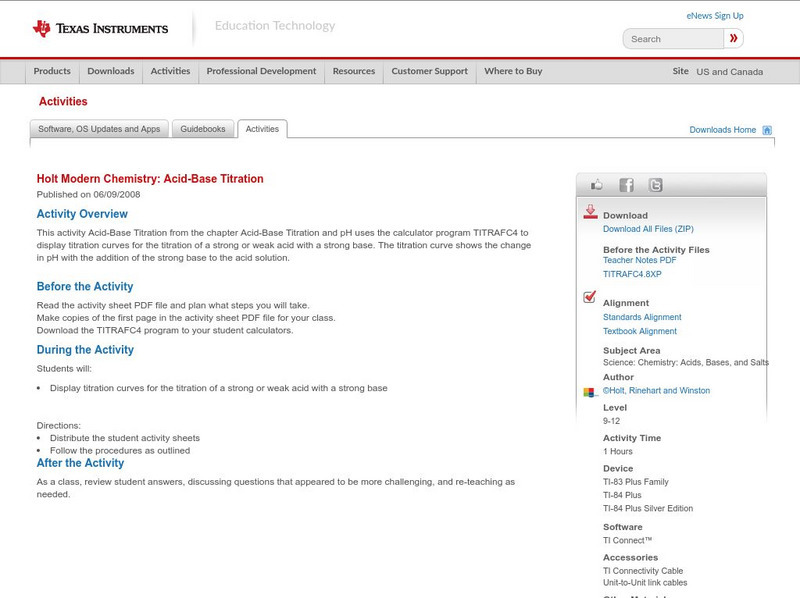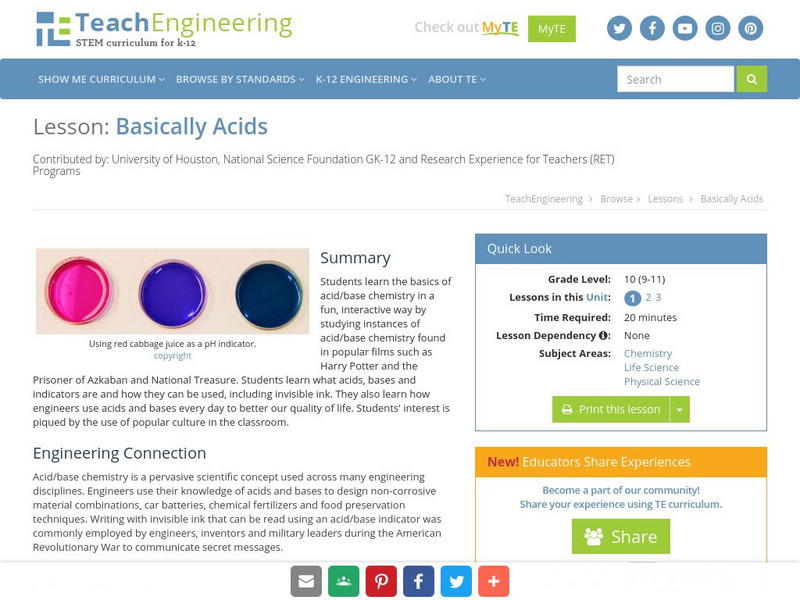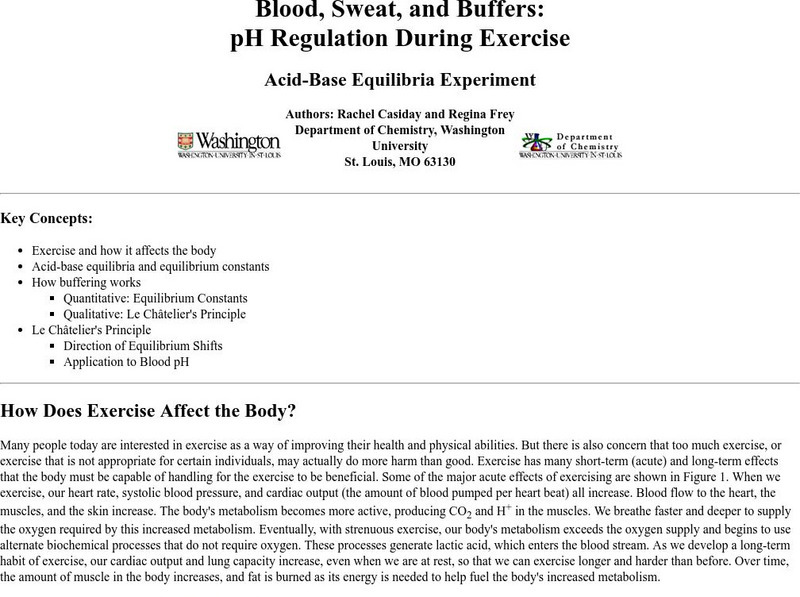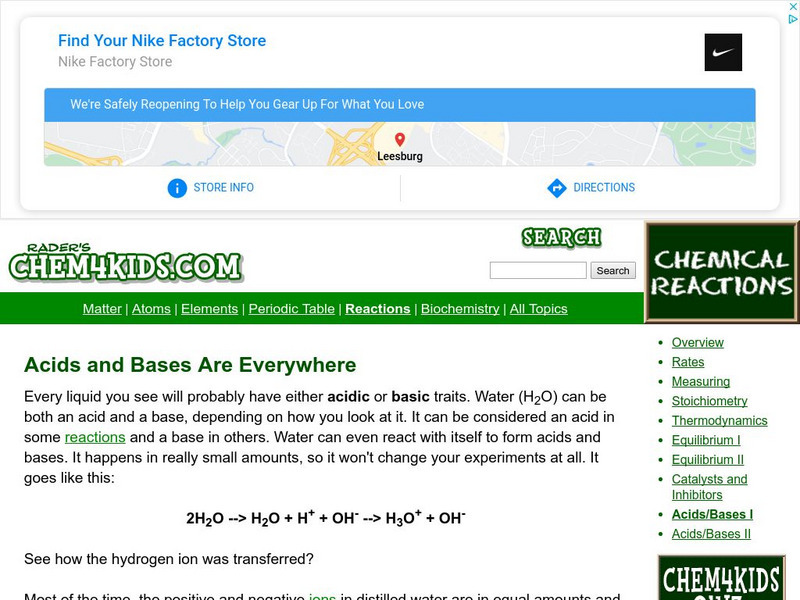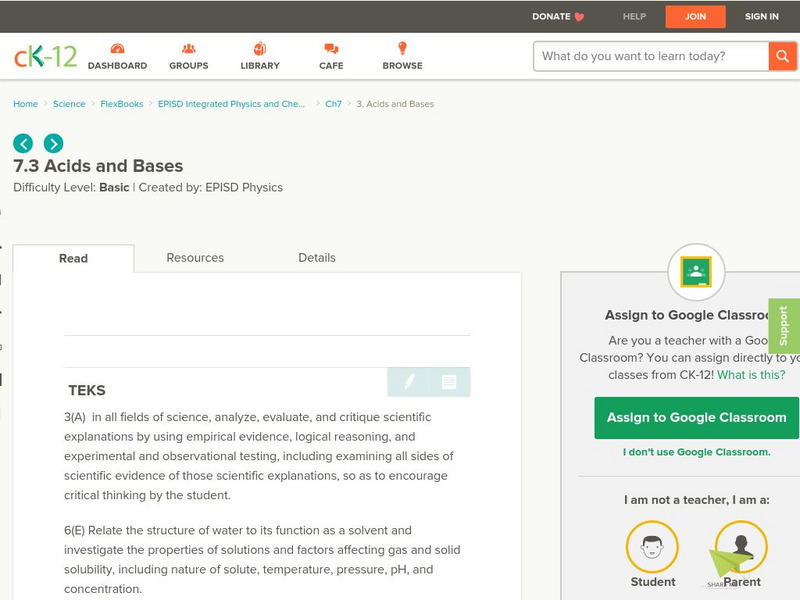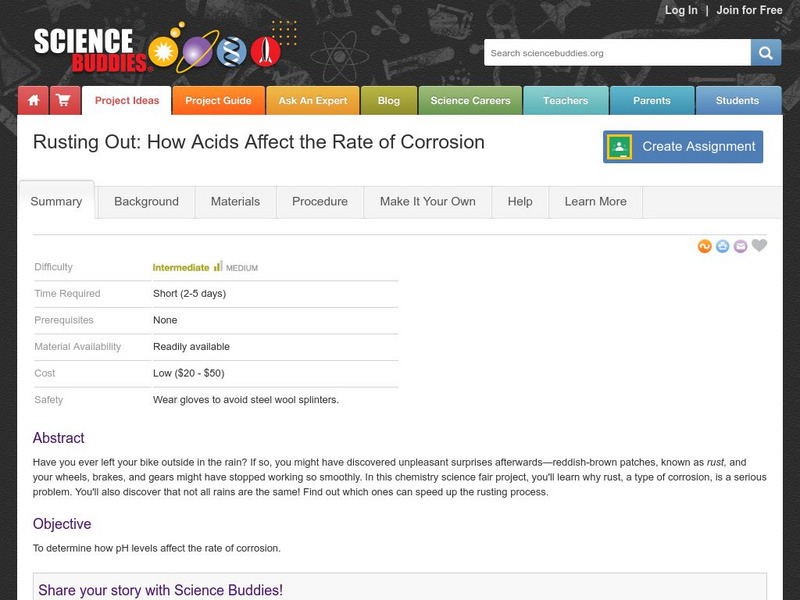Hi, what do you want to do?
Curated OER
pH of Household Products
Tenth graders are provided with a piece of paper such as index, art, construction, or computer coating it with a universal indicator. They use cotton swabs HCl and NaOH to draw a picture repeating the same process using lemon juice and...
Curated OER
Substances And Chemical Reactions
Students watch and predict chemical reactions when different substances are mixed together. They differentiate between solid, liquid, and gas.
Curated OER
Invisible Ink - Demonstration
Students observe a demonstration that shows that the indicator, phenolphthalein, is a chemical that displays different colors depending on either the acidity or the basicity of the environment. They use the substance to reveal secret...
Chiral Publishing
Chiral Publishing: An Introduction to Chemistry: Arrhenius Acid Base Reactions: Audio Book
Listen and learn about Arrhenius acid-base reactions while exploring mixtures, solutions, and their reactions. Examine the photos of the examples discussed in this website and discover how arrhenius acid-base reactions occur.
Georgia Department of Education
Ga Virtual Learning: Ap Chemistry: Acid Base and Solution Equilibrium
Through a variety of activities, students learn that not all acid and base reactions go to completion, and instead, they establish equilibrium. Acid-base equilibrium expressions have their own constants, ka and kb. Students will perform...
Simon Fraser University
Chem1 Virtual Textbook: Acid Base Equilibria
Learn about acid-base equilibria and calculations in this Chem1 Virtual e-Textbook.
CK-12 Foundation
Ck 12: Acid Base Definitions
[Free Registration/Login may be required to access all resource tools.] In this module, define acids and bases and distinguish between Arrhenius and Bronsted-Lowry definitions to predict products in acid-base reactions that form water.
Chiral Publishing
Chiral Publishing: An Introduction to Chemistry: Acids, Bases, and Acid Base Reactions [Pdf]
Find out everything you ever wanted to know about acids, bases, and acid-base reactions! This in-depth chapter discusses how to name these compounds and how they form solutions.
Texas Instruments
Texas Instruments: Holt Modern Chemistry: Acid Base Titration
This activity Acid-Base Titration from the chapter Acid-Base Titration and pH uses the calculator program TITRAFC4 to display titration curves for the titration of a strong or weak acid with a strong base. The titration curve shows the...
TeachEngineering
Teach Engineering: Basically Acids
Students learn the basics of acid/base chemistry in a fun, interactive way by studying instances of acid/base chemistry found in popular films such as Harry Potter and the Prisoner of Azkaban and National Treasure. Students learn what...
Other
Washington University: P H Buffers in the Blood
This site from the Department of Chemistry at the Washington University is an excellent site on how buffers are used in the human body and how they react to exercise.
Texas Instruments
Texas Instruments: Microscale Acid Base Titration
In this activity, students' will use a pH sensor to determine the change in pH during a titration of a known concentration of NaOH and unknown concentration of HCl. Students' will determine the concentration of unknown HCl.
Dartmouth College
Dartmouth College: Acids, Bases, and Buffers 1: Monoprotic and Polyprotic Acids
In this experiment, you will explore the behavior of the monoprotic acid (acetic acid) and the polyprotic acid (phosphoric acid). By titrating, you will examine the acid and conjugate base species present across the pH scale and the...
Dartmouth College
Dartmouth College: Chem Lab: Coordination Chemistry 3.1: Acid/base Analysis
In this experiment, you will examine the acidity of your coordination complex's water ligand. You will determine the acid dissociation constant of the complex by titrating it with a base. There are eight weeks of experiments in this series.
Royal Society of Chemistry
Royal Society of Chemistry: Gridlocks: Level 1
A collection of grid puzzles that cover topics in basic chemistry, including acids, salts, alkalis, chemistry lab equipment, the periodic table, states of matter, and more. These are excellent for topic review and reinforcement. The...
CK-12 Foundation
Ck 12: Acids and Bases
[Free Registration/Login may be required to access all resource tools.] In the following online tutorail students will define acids and bases in terms of the ions that are produced when each type of compound is dissolved in water. They...
Science Education Resource Center at Carleton College
Serc: Investigating Acids and Bases: Strong vs Weak
In this chemistry lab activity, students will study acids/bases before learning how titration data is used to determine an unknown concentration. It is an investigation of the pH curve and an assessment of student's understanding of...
Chem4kids
Chem4 Kids: Acids & Bases
This Chem4Kids site provides a general overview of acids and bases, and their use in chemistry. Content focuses on "names to know" and how acids and bases work.
Shodor Education Foundation
Shodor: Acid Base Chemistry
This Shodor Education Foundation page has a nice look at the major theories of acids and bases in less than one page. There are very simple defintions.
PBS
Zoom: Kitchen Chemistry
Did you know that chemistry can be found in your kitchen? Enter this amazing virtual world where your first stop is to the kitchen. Locate the clues and move on to the Lab Journal where you can test each item in two experiments: Cabbage...
Frostburg State University
Frostburg State General Chemistry Online: Electrolytes
These are slides eight through ten of a set of slides about Chemical reaction in solution. These slides discuss strong and weak electrolytes, acids, bases, and salts.
CK-12 Foundation
Ck 12: Acids and Bases
[Free Registration/Login may be required to access all resource tools.] In this learning module, students investigate the different chemical and physical properties of acids and bases.
Science Buddies
Science Buddies: Project Ideas: How Acids Affect the Rate of Corrosion
In this chemistry science fair project, students will investigate how pH levels affect the rate of a common form of corrosion, called rusting. The Science Buddies project ideas are set up consistently beginning with an abstract,...
Chemistry Collective
Chem Collective: Determine the Concentration of Acetic Acid in Vinegar
A virtual lab where students determine the concentration of acetic acid in vinegar using a 0.110 M NaOH standard solution and an acid-base indicator, phenolphthalein.












![Chiral Publishing: An Introduction to Chemistry: Acids, Bases, and Acid Base Reactions [Pdf] eBook Chiral Publishing: An Introduction to Chemistry: Acids, Bases, and Acid Base Reactions [Pdf] eBook](https://static.lp.lexp.cloud/images/attachment_defaults/resource/large/FPO-knovation.png)
